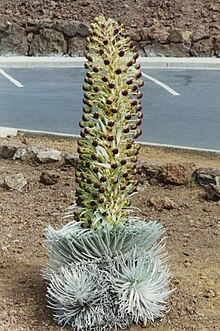Argyroxiphium
| silverswords greenswords | |
|---|---|

| |
| Haleakalā Silversword | |
| Scientific classification | |
| Kingdom: | |
| (unranked): | |
| (unranked): | |
| (unranked): | |
| Order: | |
| Family: | |
| Subfamily: | |
| Tribe: | |
| Genus: | Argyroxiphium |
| Synonyms[2] | |
|
Argyrophyton Hook. | |
Argyroxiphium is a small genus of plants in the sunflower family, Asteraceae.[3][4] Its members are known by the common names of silversword or greensword due to their long, narrow leaves and the silvery hairs on some species. It belongs to a larger radiation of over 50 species, including the physically different genera Dubautia and Wilkesia. This grouping is often referred to as the silversword alliance.
Description
These perennials are endemic to Hawaiʻi, occurring only on the islands of Maui and Hawaiʻi in an extremely localized distribution. They are primarily found above 1,500 m (4,900 ft) in elevation in alpine deserts or bogs, indicating an adaptation to low-nutrient soils. The Kaʻū or Mauna Loa Silversword (A. kauense) is the most adaptable: it can be found in rocky lava flows, bogs, and open forest.
They consist of rosette-forming epigeal shrubs or dwarf shrubs. They may consist of a single large rosette (Mauna Kea and Haleakalā silverswords), a short-branched rosette (Mauna Loa Silversword), or spreading with runners (ʻEke Silversword, greenswords). The flower heads consist of a ring of pistillate ray florets around 30 to 600 disk florets. The corolla varies in color from purplish to wine red or yellow, while the anthers are dark. A rosette will grow from 5–20 years before flowering, after which it dies. For those with a single rosette, this means the death of the plant (in contrast, those reproducing by runners rarely flower and may be very long-lived). Because they require cross-pollination by insects, many plants must flower at the same time in relatively close proximity or they will fail to set seed. A significant population must exist for enough to flower each year for pollination to occur.
Despite appearances, they are very closely related to the genus Dubautia. Although some Dubautia are radically different from silverswords, those found in wet forests and alpine deserts clearly grade into the form of silverswords. Hybrids between Argyroxiphium sandwicense and Dubautia menziesii are common in Haleakalā Crater. Although the two species are quite distinct, the hybrids span the entire range of variation between them.
Conservation
Silverswords and greenswords are highly sensitive to disturbance. Their shallow root systems are easily crushed in the boggy soil or loose volcanic cinders they grow in. The succulent leaves are eaten by goats in the dry summits, and pigs frequently disturb the fragile bog vegetation. All species are highly restricted in range, and even those that are protected are vulnerable to catastrophic events. The East Maui Greensword (A. virescens) is apparently extinct, but in 1989 plants were discovered that appear to be hybrids between it and the Haleakalā Silversword.[5] The Mauna Kea and Mauna Loa silverswords both have small populations, but are being cultivated and outplanted in protected areas. The largest population of Mauna Loa Silverswords is in Kahuku, which was recently acquired by Hawaii Volcanoes National Park.[6]
Species
- accepted species[2]
- Argyroxiphium caliginis C.N.Forbes – ʻEke Silversword
- Argyroxiphium grayanum (Hillebr.) O. Deg. – Greensword
- Argyroxiphium × kai D.D.Keck (A. caliginis × A. grayanum)
- Argyroxiphium kauense (Rock & M.Neal) O.Deg. & I.Deg. – Mauna Loa or Kaʻū Silversword
- Argyroxiphium sandwicense DC. – Silversword
- Argyroxiphium sandwicense ssp. sandwicense DC. – Mauna Kea Silversword
- Argyroxiphium sandwicense ssp. macrocephalum (A.Gray) Meyrat – Haleakalā Silversword
- Argyroxiphium virescens Hillebr. – East Maui Greensword (extinct)
- formerly included[2]
now in Dubautia
- A. gymnoxiphium - Dubautia gymnoxiphium
Gallery
-
Greensword
-
Greensword, Puʻu Kukui bog
-
Haleakalā Silversword
-
Silversword in Haleakalā Crater
-
Dubautia-silversword hybrid in Haleakalā Crater
-
Mauna Kea Silversword
-
Mauna Kea Silversword
-
Mauna Kea Silversword flowering
-
Mauna Kea Silversword
-
Mauna Loa Silversword habitat, Kahuku
-
Mauna Loa Silversword, multiple rosettes
-
Mauna Loa Silversword, single rosette
-
Haleakalā Silversword (close-up)
References
- ^ "Genus Argyroxiphium". Taxonomy. UniProt. Retrieved 2009-04-06.
- ^ a b c Flann, C (ed) 2009+ Global Compositae Checklist
- ^ Candolle, Augustin Pyramus de. 1836. Prodromus Systematis Naturalis Regni Vegetabilis 5: 668
- ^ Tropicos, Argyroxiphium DC.
- ^ Carr, Gerald (1997-03-20). "Argyroxiphium virescens Hillebrand". Hawaiian Silversword Alliance. University of Hawaii. Archived from the original on 18 September 2009. Retrieved 2009-11-01.
{{cite web}}: Unknown parameter|deadurl=ignored (|url-status=suggested) (help) - ^ Flora of the Hawaiian Islands, Smithsonian Institution National Museum of Natural History,













